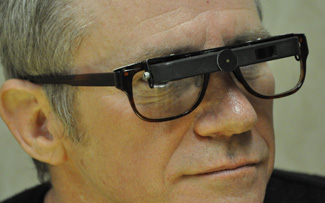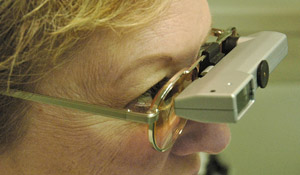Driving and Achromatopsia
"All great truths begin as blasphemies"
- George Bernard Shaw
Today, many achromats can become licensed drivers. To be licensed with achromatopsia first depends on the degree of vision loss. Patients with blue cone monochromatism may have better visual acuity allowing some of them to obtain a driver’s license without special devices. However, most achromats have vision loss in the 20/80 to 20/160 range and thus require bioptic eyewear to reach a level of visual acuity for driving.
The development of bioptic eyewear and the improvements in filtered soft contact lens allows more achromats the option of bioptic driving. It is a difficult process, which is dependent on the vision and motivation of the patient. It is not an option for  every patient. Full control of glare and light must be achieved before driving can be considered. Issues of colorblindness and the ability to detect traffic signals must be resolved. The achromat driver must be highly motivated to overcome the impact of the debilitating glare and color blindness effects on driving. About 80% of states in the USA license bioptic drivers. The requirements vary in each state.Strategies and filters to assist seeing traffic lights must be employed.
every patient. Full control of glare and light must be achieved before driving can be considered. Issues of colorblindness and the ability to detect traffic signals must be resolved. The achromat driver must be highly motivated to overcome the impact of the debilitating glare and color blindness effects on driving. About 80% of states in the USA license bioptic drivers. The requirements vary in each state.Strategies and filters to assist seeing traffic lights must be employed.
Bioptic Driving
Bioptic systems combine prescription eyewear with a small telescopic system. The eyewear lens portion is deemed the carrier, which provides general vision while the telescope aids in quick spotting of detail for the visually impaired patient.
while the telescope aids in quick spotting of detail for the visually impaired patient.
Bioptic drivers are required to have adequate side vision. Bioptic drivers drive with carrier lenses 95 percent of time or more. The bioptic telescope is only used to do quick spotting such as to read a traffic sign or check a distant traffic light or check events far down the road. It is used much the way we all take a quick look in the rear view mirror.
For bioptic driving to become an option, we must first control the light adequately to stop the squinting and blinking in sunlight and stabilize visual acuity and the visual field. A squinting patient will have a smaller functional  visual field. For sunlight driving, the combination of filtered contact lenses and sun filters additional filters used on the bioptic eyewear is required.
visual field. For sunlight driving, the combination of filtered contact lenses and sun filters additional filters used on the bioptic eyewear is required.
The ability to handle the color vision needs of driving must be addressed. In some patients, special enhancement/subtraction filters may be applied as needed to aid in determining red versus green traffic lights. The ability to function with traffic lights and brake lights is critical. Some incomplete achromats may see some colors with their trace residual color vision.
Other achromats learn to determine traffic signals by the position on the light. This can be difficult from longer distances. The recent trends to use one light with a LED light changing color or the mounting of lights horizontally could impair some achromats who depend only on light position.
To aid these patients, a small additional red filter may be added in a strip below the bioptic eyepiece. This allows the achromat to check the light to verify color. If the traffic light is green the light will disappear in the red filter. If red, the light will appear and stand out better. Dr. Eli Peli, senior research scientist at Harvard's Schepen's Eye Research Institute has also demonstrated that tinting the upper portion of the lenses dark red can be helpful.
Achromats usually respond adequately to brake lights applied in the car directly in front of them, but in a line of traffic, achromats may not be as good at detecting brake lights several cars ahead. This is because, an achromat may see the brake lights as a change in the brightness of gray not as the brilliant red most of us see. Thus the achromat is taught to increase the gap maintained between their car and the car in front of them.
Then extensive behind-the-wheel driver’s training (30 hours in Indiana) is required with a driving rehabilitation specialist. Once training is completed, an extended behind-the-wheel driving examination by the Bureau of Motor Vehicles is required. The state examiner makes the final certification of the achromat's ability to be licensed.
In our patient stories section you will find the stories of some of our bioptic drivers. The Low Vision Centers of Indiana have developed an extensive national website on bioptic driving at BiopticDrivingUSA.com. The brief movie below will introduce you to our site on bioptic driving.
